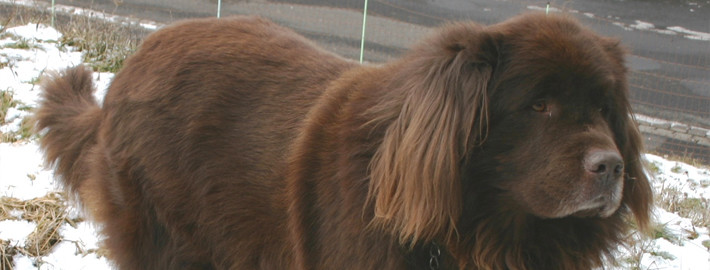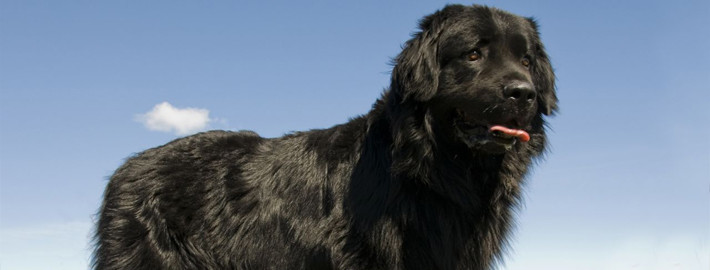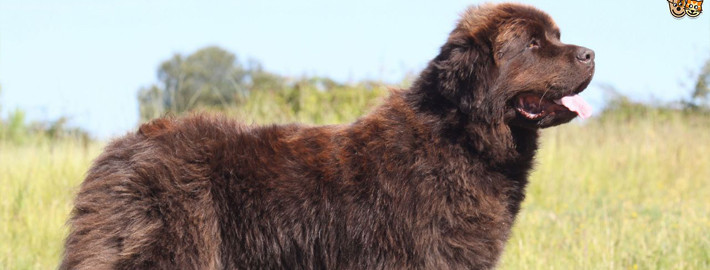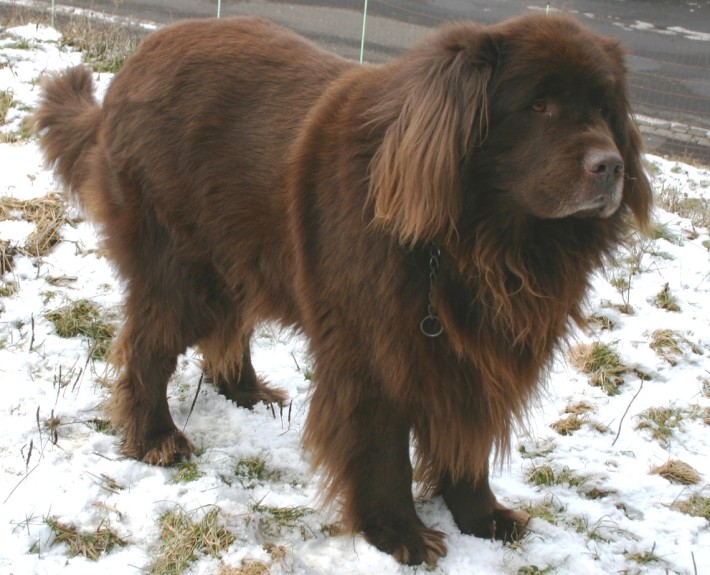What makes the Newfoundland Unique?
The Newfoundland is a large, heavy-boned, powerful dog that is strong enough to pull a drowning man from rough seas and imposing enough to make an effective guard dog. It is slightly longer than it is tall. Its gait gives the impression of effortless power, with good reach and drive. Its double coat consists of a soft, dense undercoat and a coarse, moderately long and straight outer coat. Its soft expression reflects its benevolent and dignified temperament. The most important single characteristic of the Newfoundland is sweetness of temperament. The Newfoundland is calm, patient, easygoing, gentle and amiable — a friend to all. If its family is threatened, however, the Newfoundland can act protectively.
Page Contents
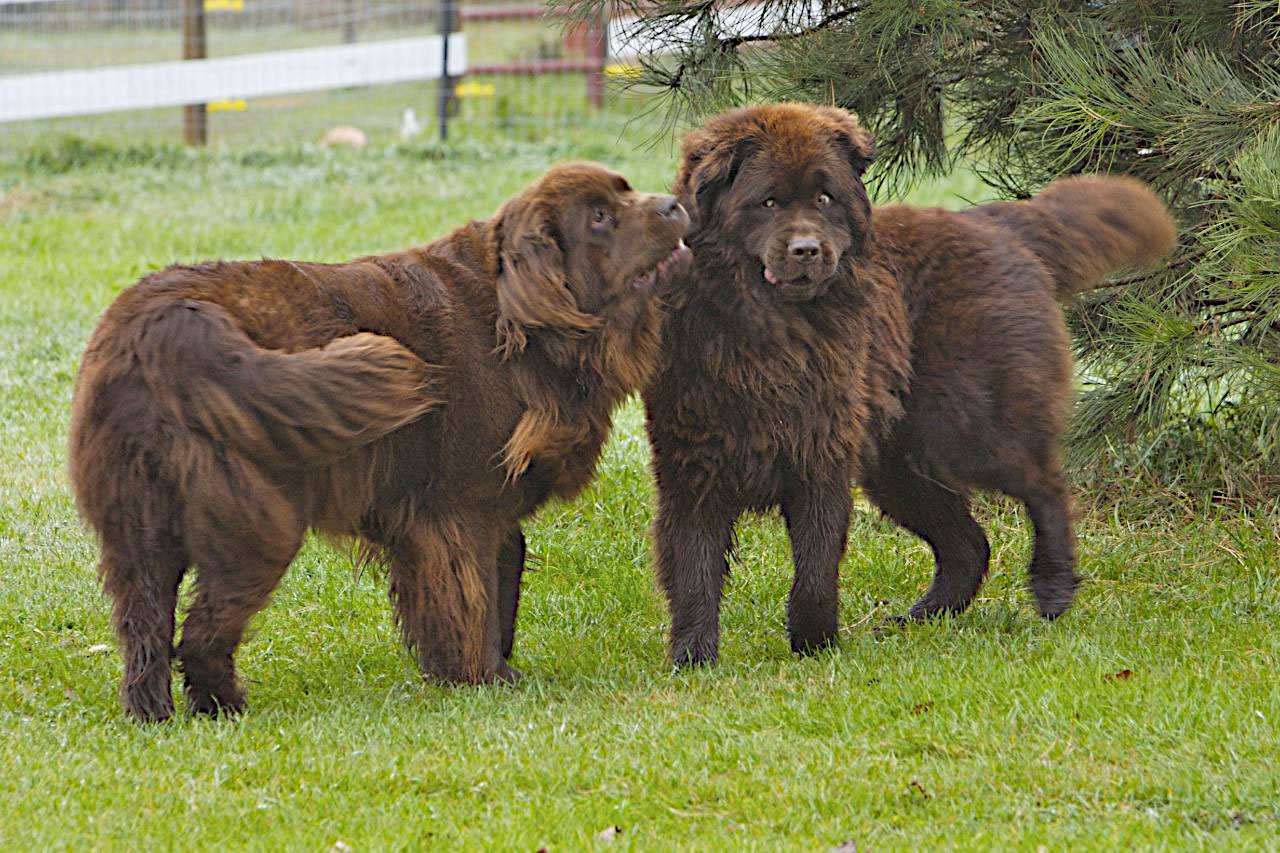
Is the Newfoundland Right For You?
The Newfoundland’s sweet disposition makes him a good fit for families. Although he appears somewhat docile, he is an active dog and will need daily exercise. Regular brushing is important to maintain his plush coat. Newfs are also an intelligent breed and are readily trained. If you are considering purchasing a Newfoundland puppy, learn more. *Working Group; AKC recognized in 1886.
*Ranging in size from 26 to 28 inches tall at the shoulder and 100 to 150 pounds.
*Multipurpose dog; water rescue.
In 5 Words
- Gentle
- Trainable
- Sweet-Tempered
- Patient
- Calm
Characteristics
Learn About the Newfoundland
Description
The Newfoundland is a dog with an outstanding, sweet temperament, courageous, generous, peaceable and intelligent. A calm, patient dog that is mild with guests and obedient with its master. They are very devoted, loyal and trustworthy. Its huge body tends to move rather slowly. They rarely bark, but are protective and brave when they need to be. When an intruder is caught they are more likely to hold them at bay, either by trapping them in a corner or placing themselves in between the burglar and the family rather than an all-out attack. They are smart enough to know who is a threat to the pack and who is not. Very sociable and gentle. Any dog, other animal, child, or visitor who has no evil intention will receive a friendly welcome. The Newfoundland usually gets along with other dogs, but should be socialize well with them, giving a correction at any sign of aggressiveness to insure this behavior. Generally good with other animals. Patient, playful and loving with children. Enjoys the outdoors, but also needs to be with their family. The Newfoundland tends to be very messy when drinking water and often drinks a lot. They do drool, especially after getting a drink, but generally are not one of the worst offenders compared to some other giant breeds. They love to swim, and will lie in water if they get the chance. This breed may be slightly difficult to train. Training must be conducted in a calm and balanced manner. In order to achieve a well balanced dog one must be calm, but firm, confident and consistent with the dog. Give the dog rules he must follow and stick to them, along with a daily pack walk where the dog must heel beside or behind you. No pulling ahead. Teach the dog to enter and exit door and gateways after the human. These dogs are very sensitive to the tone of your voice. Take this into account during training; one needs to be calm, but firm. Adult Newfoundlands eat only about as much as a Labrador, but puppies eat more.
Short History of the Newfoundland
The Newfoundland shares many traits with other mastiffs, such as the St. Bernard and English mastiff, including stout legs, massive heads with very broad snouts, a thick bull neck, and a very sturdy bone structure. In fact, many St. Bernard Dogs have Newfoundland Dog ancestry. Newfoundlands were brought and introduced to the St. Bernard breed in the 18th century when the population was threatened by an epidemic of distemper. They share many characteristics of many mountain dog breeds such as the Great Pyrenees.
The Newfoundland breed originated in Newfoundland, and is descended from a breed indigenous to the island known as the lesser Newfoundland, or St. John’s Dog. The mastiff characteristics of the Newfoundland are likely a result of breeding with Portuguese Mastiffs brought to the island by Portuguese fishermen beginning in the 16th century.
The speculation that Newfoundlands may be partly descended from big black bear dogs introduced by the Vikings in 1001 A.D. is based more in romance than in fact.
By the time colonization was permitted in Newfoundland in 1610, the distinct physical characteristics and mental attributes had been established in the Newfoundland breed. In the early 1880s, fishermen and explorers from Ireland and England traveled to the Grand Banks of Newfoundland, where they described two main types of working dog. One was heavily built, large with a longish coat, and the other medium-sized in build – an active, smooth-coated water dog. The heavier breed was known as the Greater Newfoundland, or Newfoundland. The smaller breed was known as the Lesser Newfoundland, or St. John’s Dog. The St. John’s Dog became the founding breed of the modern retrievers. Both breeds were used as working dogs to pull fish nets, with the Greater Newfoundland also being used to haul carts and other equipment.
Because of that, they were part of the foundation stock of the Leonberger (which excelled at water rescue and was imported by the Canadian government for that purpose); and the now extinct Moscow Water Dog, a failed attempt at creating a lifesaving dog by the Russian state kennel—the unfortunate outcross with the Caucasian Ovcharka begat a biting and not a rescuing dog.
Many tales have been told of the courage displayed by Newfoundlands in adventuring and lifesaving exploits. Over the last two centuries, this has inspired a number of artists, who have portrayed the dogs in paint, stone, bronze and porcelain. One famous Newfoundland was a dog named Seaman, who accompanied American explorers Lewis and Clark on their expedition.
The breed’s working role was varied and another famous all black Newfoundland performed as the star attraction in Van Hare’s Magic Circus from 1862 and for many years thereafter in one England’s founding circus acts, traveling throughout Europe. The circus dog was known as the “Thousand Guinea Dog Napoleon” or “Napoleon the Wonder Dog”. Van Hare trained other Newfoundland dogs to perform a steeplechase routine, with baboons dressed up as jockeys to ride them. Nonetheless, his “wizard dog” Napoleon was his favorite and would compete at jumping against human rivals, leaping over horses from a springboard, and dancing to music.
The breed prospered in the United Kingdom, until 1914 and again in 1939, when its numbers were almost fatally depleted by wartime restrictions. Since the 1950s there has been a steady increase in numbers and popularity, despite the fact that the Newfoundland’s great size and fondness for mud and water makes it unsuitable as a pet for many households.
Temperament
The Newfoundland’s gentle and intelligent expression reflects it amiability and friendliness toward humans. It is regarded as one of the most intelligent dog breeds; as such, it is easily trained and enjoys the process of working with humans.
As family dogs go, the Newfoundland breed is at the top. Ever patient and loyal, it is more likely that the dog will be abused by the children in its keep than for the dog to ever harm a child. In all respects, this breed is the best suited for children.
Although aggression is never an outward trait of the Newfoundland, it will guard its human family and will position itself between the threatening intruder and the people it is protecting, exhibiting aggression only when necessary.
Caring for Your Newfoundland
General Health
The Newfoundland, which has an average lifespan of 8 to 10 years, is prone to serious health conditions such as gastric torsion, Sub-Aortic Stenosis (SAS), cystinuria, canine hip dysplasia (CHD), epilepsy, and elbow dysplasia, and minor issues like von Willebrand’s Disease (vWD), cataract, Osteochondrosis Dissecans (OCD), entropion, ectropion, cruciate ligament rupture. To identify some of these issues, a veterinarian may recommend cardiac, eye, hip, and elbow tests for this breed of dog. Additionally, some Newfoundlands are extremely sensitive to anesthesia, and most do not tolerate heat well.
Grooming & Bathing
Because of its heavy coat, the Newfie does not fare well in hot weather. It should be kept outdoors only in cold or temperate weather, and in summer, the coat may be trimmed for neatness and comfort, and brushed daily to manage excess shedding and prevent the coat from matting. The dog is at its best when it can move freely between the yard and the house, but still needs plenty of space indoors to stretch properly. Daily exercise is essential, as is typical with all work dogs.
Although its relaxed appearance might indicate that this breed would prefer to lounge around, the Newfie has an abundance of energy that needs to be spent in order for the dog to be at its top shape. Regular walks and romps in the park or in a large yard will keep the Newfie fit and content. Being large dogs, they do have larger appetites, but care must be taken not to overfeed them, as they can easily become overweight, stressing the organs extremities and shortening their lifespans.
In the summer, the Newfoundlander is more likely to drool, since it must pant more to keep its body temperature down, owing to its size and coat. Summertime water activities are ideal, since the Newfie excels at swimming, but keep in mind that even in the winter this breed benefits from a brisk swim. Cold water swimming is what they are built for, after all. According to some breeders, the Landseers are more active, thus requiring more exercise. In fact, it is ideal for families who enjoy camping, fishing, or hiking with an enthusiastic participant and helpful furry companion.
Exercise & Training
This gentle giant is quite content to laze around the house, but still needs to be taken on a daily walk. While out on the walk the dog must be made to heel beside or behind the person holding the lead, as in a dog’s mind the leader leads the way, and that leader needs to be the human. It will enjoy frequent opportunities to swim and frolic.

